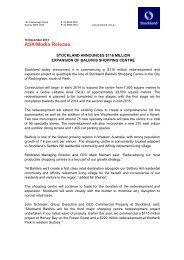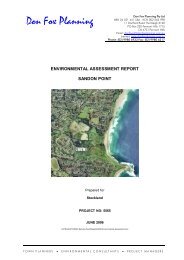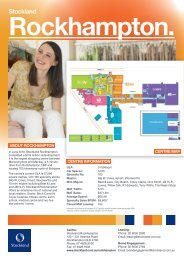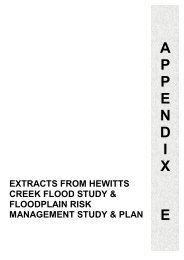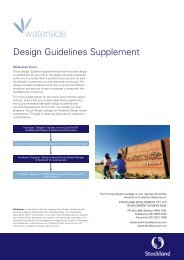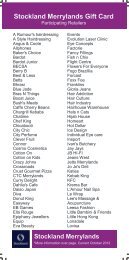Stockland Direct Retail Trust No.1
Stockland Direct Retail Trust No.1
Stockland Direct Retail Trust No.1
You also want an ePaper? Increase the reach of your titles
YUMPU automatically turns print PDFs into web optimized ePapers that Google loves.
<strong>Stockland</strong> <strong>Direct</strong> <strong>Retail</strong> <strong>Trust</strong> No. 1 and its controlled entities<br />
Notes to the Consolidated Financial Statements<br />
For the Year Ended 30 June 2009<br />
20 Financial instruments (continued)<br />
(a) Financial risk and capital management (continued)<br />
Credit risk (continued)<br />
The movement in the allowance for impairment loss is as follows:<br />
Consolidated<br />
<strong>Trust</strong><br />
2009 2008 2009 2008<br />
$’000 $’000 $’000 $’000<br />
Balance as at 1 July – – – –<br />
Charge for the year 14 – – –<br />
Amounts written off – – – –<br />
Closing balance at 30 June 14 – – –<br />
The carrying amount of financial assets included in the Balance Sheet represents the consolidated entity’s and the <strong>Trust</strong>’s maximum exposure to credit risk in relation to these assets.<br />
Refer to Notes 5 and 6 for a breakdown of these financial assets.<br />
Liquidity risk<br />
Liquidity risk is the risk that the consolidated entity or the <strong>Trust</strong> will not be able to meet its financial obligations as they fall due. Prudent liquidity risk management implies maintaining sufficient<br />
cash and cash equivalents, the availability of funding through an adequate amount of committed credit facilities and the ability to close out market positions. The consolidated entity and the<br />
<strong>Trust</strong> aims at maintaining flexibility in funding by keeping sufficient committed credit lines available. Management prepares and monitors rolling forecasts of liquidity requirements on the basis<br />
of expected cash flow.<br />
The consolidated entity manages liquidity risk through monitoring the maturity of its debt portfolio. As at 30 June 2009, the current weighted average debt maturity is 0.5 years (2008: 1.5 years).<br />
Refer to Note 14 for further detail of the loan facility.<br />
The table below reflects all contractual maturities of financial liabilities including principal and estimated interest cash flows calculated based on conditions existing at balance date. The amounts<br />
presented represent the future undiscounted cash flows and may not equate to carrying amounts of financial liabilities in the Balance Sheet.<br />
Contractual maturity of financial liabilities including derivatives and estimated interest<br />
2009 2008<br />
Contractual<br />
Contractual<br />
cash flows 1 year or less 1-3 years 3-5 years 5+ years cash flows 1 year or less 1-3 years 3-5 years 5+ years<br />
$’000 $’000 $’000 $’000 $’000 $’000 $’000 $’000 $’000 $’000<br />
Consolidated<br />
Trade payables and accruals (1,624) (1,624) – – – (2,464) (2,464) – – –<br />
Distribution payable (622) (622) – – – (778) (778) – – –<br />
Loan facility 1 (58,102) (58,102) – – – (62,952) (4,611) (58,341) – –<br />
Interest rate swap (688) (1,301) (157) 770 – 3,787 1,029 1,504 1,047 207<br />
(61,036) (61,649) (157) 770 – (62,407) (6,824) (56,837) 1,047 207<br />
<strong>Trust</strong><br />
Trade payables and accruals (600) (600) – – – (358) (358) – – –<br />
Distribution payable (622) (622) – – – (778) (778) – – –<br />
Loan facility 1 (58,102) (58,102) – – – (62,952) (4,611) (58,341) – –<br />
Interest rate swap (688) (1,301) (157) 770 – 3,787 1,029 1,504 1,047 207<br />
(60,012) (60,625) (157) 770 – (60,301) (4,718) (56,837) 1,047 207<br />
1<br />
The loan facility is due to mature on 22 December 2009. Refer to Note 14 for further detail.<br />
<strong>Stockland</strong> <strong>Direct</strong> <strong>Retail</strong> <strong>Trust</strong> No. 1 June 2009 21



